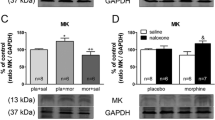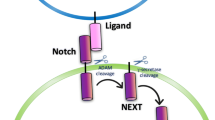Abstract
Glial cell line-derived neurotrophic factor (GDNF) is a potent neurotrophic factor for midbrain dopamine (DA) neurons, while the DA neurons in the ventral tegmental area (VTA) is a crucial part of the neural circuits associated with drug addiction. Recently, more and more evidence suggests that GDNF plays an important role in negatively regulating the neuroadaptations induced by chronic exposure to drugs, which was thought to be the neurobiological basis of drug addiction, but the underlying mechanism is still unknown. More recently, the neural cell adhesion molecule (NCAM), which plays an important role in the process of neural plasticity, has been identified as an alternative signaling receptor for GDNF. The purpose of this study was to investigate whether NCAM was involved in the effects of GDNF on the neuroadaptations induced by chronic morphine exposure. Immunostaining results showed that NCAM was widely expressed in the VTA of rats, including all the DA neurons. The results also showed that the phosphorylation of NCAM-associated FAK, but not the total NCAM, was upregulated by GDNF, and this upregulation was inhibited by pre-treatment with the NCAM function-blocking antibody. Moreover, pre-treatment with the antibody could antagonize the effect of GDNF on inhibiting the neuroadaptations induced by chronic morphine exposure, including the decreases of the number and length of neurites and the size of cell bodies of VTA dopamine neurons, as well as the increase of tyrosine hydroxylase in the VTA dopamine neurons. These results suggest that NCAM signaling is involved in the negative regulatory effects of GDNF on chronic morphine-induced neuroadaptations.





Similar content being viewed by others
Abbreviations
- GDNF:
-
Glial cell line-derived neurotrophic factor
- NCAM:
-
Neural cell adhesion molecule
- FAK:
-
Focal adhesion kinase
- VTA:
-
Ventral tegmental area
- DA:
-
Dopamine
- TH:
-
Tyrosine hydroxylase
References
Alzoubi KH, Srivareerat M, Aleisa AM, Alkadhi KA (2013) Chronic caffeine treatment prevents stress-induced LTP impairment: the critical role of phosphorylated CaMKII and BDNF. J Mol Neurosci 49:11–20
Barak S, Ahmadiantehrani S, Kharazia V, Ron D (2011a) Positive autoregulation of GDNF levels in the ventral tegmental area mediates long-lasting inhibition of excessive alcohol consumption. Transl Psychiatry 1
Barak S, Carnicella S, Yowell QV, Ron D (2011b) Glial cell line-derived neurotrophic factor reverses alcohol-induced allostasis of the mesolimbic dopaminergic system: implications for alcohol reward and seeking. J Neurosci 31:9885–9894
Barker JM, Torregrossa MM, Taylor JR (2012) Low prefrontal PSA-NCAM confers risk for alcoholism-related behavior. Nat Neurosci 15:1356–1358
Beggs HE, Baragona SC, Hemperly JJ, Maness PF (1997) NCAM140 interacts with the focal adhesion kinase p125(fak) and the SRC-related tyrosine kinase p59(fyn). J Biol Chem 272:8310–8319
Berhow MT, Hiroi N, Nestler EJ (1996) Regulation of ERK (extracellular signal regulated kinase), part of the neurotrophin signal transduction cascade, in the rat mesolimbic dopamine system by chronic exposure to morphine or cocaine. J Neurosci 16:4707–4715
Carnicella S, Ron D (2009) GDNF—a potential target to treat addiction. Pharmacol Ther 122:9–18
Chao CC, Ma YL, Chu KY, Lee EH (2003) Integrin alphav and NCAM mediate the effects of GDNF on DA neuron survival, outgrowth, DA turnover and motor activity in rats. Neurobiol Aging 24:105–116
Cox ET, Brennaman LH, Gable KL, Hamer RM, Glantz LA, Lamantia AS, Lieberman JA, Gilmore JH, Maness PF, Jarskog LF (2009) Developmental regulation of neural cell adhesion molecule in human prefrontal cortex. Neuroscience 162:96–105
Cremer H, Chazal G, Carleton A, Goridis C, Vincent JD, Lledo PM (1998) Long-term but not short-term plasticity at mossy fiber synapses is impaired in neural cell adhesion molecule-deficient mice. Proc Natl Acad Sci U S A 95:13242–13247
Di Chiara G, North RA (1992) Neurobiology of opiate abuse. Trends Pharmacol Sci 13:185–193
Durbec P, Marcos-Gutierrez CV, Kilkenny C, Grigoriou M, Wartiowaara K, Suvanto P, Smith D, Ponder B, Costantini F, Saarma M et al (1996) GDNF signalling through the Ret receptor tyrosine kinase. Nature 381:789–793
Ghitza UE, Zhai H, Wu P, Airavaara M, Shaham Y, Lu L (2010) Role of BDNF and GDNF in drug reward and relapse: a review. Neurosci Biobehav Rev 35:157–171
Gong P, Zheng A, Chen D, Ge W, Lv C, Zhang K, Gao X, Zhang F (2009) Effect of BDNF Val66Met polymorphism on digital working memory and spatial localization in a healthy Chinese Han population. J Mol Neurosci 38:250–256
He DY, Ron D (2008) Glial cell line-derived neurotrophic factor reverses ethanol-mediated increases in tyrosine hydroxylase immunoreactivity via altering the activity of heat shock protein 90. J Biol Chem 283:12811–12818
Hinsby AM, Berezin V, Bock E (2004) Molecular mechanisms of NCAM function. Front Biosci 9:2227–2244
Inoue Y, Yao L, Hopf FW, Fan P, Jiang Z, Bonci A, Diamond I (2007) Nicotine and ethanol activate protein kinase A synergistically via G(i) betagamma subunits in nucleus accumbens/ventral tegmental cocultures: the role of dopamine D(1)/D(2) and adenosine A(2A) receptors. J Pharmacol Exp Ther 322:23–29
Kalivas PW, McFarland K (2003) Brain circuitry and the reinstatement of cocaine-seeking behavior. Psychopharmacol (Berl) 168:44–56
Kalivas PW, O'Brien C (2008) Drug addiction as a pathology of staged neuroplasticity. Neuropsychopharmacology 33:166–180
Kalivas PW, Volkow ND (2005) The neural basis of addiction: a pathology of motivation and choice. Am J Psychiatry 162:1403–1413
Kastin AJ, Akerstrom V, Pan W (2003) Glial cell line-derived neurotrophic factor does not enter normal mouse brain. Neurosci Lett 340:239–241
Kelley AE, Berridge KC (2002) The neuroscience of natural rewards: relevance to addictive drugs. J Neurosci 22:3306–3311
Kolkova K, Novitskaya V, Pedersen N, Berezin V, Bock E (2000) Neural cell adhesion molecule-stimulated neurite outgrowth depends on activation of protein kinase C and the Ras-mitogen-activated protein kinase pathway. J Neurosci 20:2238–2246
Lin LF, Doherty DH, Lile JD, Bektesh S, Collins F (1993) GDNF: a glial cell line-derived neurotrophic factor for midbrain dopaminergic neurons. Science 260:1130–1132
Mackowiak M, Mordalska P, Dudys D, Korostynski M, Bator E, Wedzony K (2011) Cocaine enhances ST8SiaII mRNA expression and neural cell adhesion molecule polysialylation in the rat medial prefrontal cortex. Neuroscience 186:21–31
Maldonado R (2003) The neurobiology of addiction. J Neural Transm Suppl 1–14
Maness PF, Beggs HE, Klinz SG, Morse WR (1996) Selective neural cell adhesion molecule signaling by Src family tyrosine kinases and tyrosine phosphatases. Perspect Dev Neurobiol 4:169–181
Markram K, Gerardy-Schahn R, Sandi C (2007) Selective learning and memory impairments in mice deficient for polysialylated NCAM in adulthood. Neuroscience 144:788–796
Messer CJ, Eisch AJ, Carlezon WA Jr, Whisler K, Shen L, Wolf DH, Westphal H, Collins F, Russell DS, Nestler EJ (2000) Role for GDNF in biochemical and behavioral adaptations to drugs of abuse. Neuron 26:247–257
Nestler EJ (2001) Molecular basis of long-term plasticity underlying addiction. Nat Rev Neurosci 2:119–128
Nicole O, Ali C, Docagne F, Plawinski L, MacKenzie ET, Vivien D, Buisson A (2001) Neuroprotection mediated by glial cell line-derived neurotrophic factor: involvement of a reduction of NMDA-induced calcium influx by the mitogen-activated protein kinase pathway. J Neurosci 21:3024–3033
Paratcha G, Ledda F, Ibanez CF (2003) The neural cell adhesion molecule NCAM is an alternative signaling receptor for GDNF family ligands. Cell 113:867–879
Pascual A, Hidalgo-Figueroa M, Piruat JI, Pintado CO, Gomez-Diaz R, Lopez-Barneo J (2008) Absolute requirement of GDNF for adult catecholaminergic neuron survival. Nat Neurosci 11:755–761
Pierce RC, Kumaresan V (2006) The mesolimbic dopamine system: the final common pathway for the reinforcing effect of drugs of abuse? Neurosci Biobehav Rev 30:215–238
Saffell JL, Doherty P, Tiveron MC, Morris RJ, Walsh FS (1995) NCAM requires a cytoplasmic domain to function as a neurite outgrowth-promoting neuronal receptor. Mol Cell Neurosci 6:521–531
Sklair-Tavron L, Shi WX, Lane SB, Harris HW, Bunney BS, Nestler EJ (1996) Chronic morphine induces visible changes in the morphology of mesolimbic dopamine neurons. Proc Natl Acad Sci U S A 93:11202–11207
Smith-Swintosky VL, Gozes I, Brenneman DE, D'Andrea MR, Plata-Salaman CR (2005) Activity-dependent neurotrophic factor-9 and NAP promote neurite outgrowth in rat hippocampal and cortical cultures. J Mol Neurosci 25:225–238
Suder P, Bogusiewicz A, Rolka K, Laidler P, Kotlinska J, Silberring J (2003) Rat neuronal cells in primary culture as a model for nociceptin/orphanin FQ metabolism. Neurosci Lett 348:167–170
Treanor JJ, Goodman L, de Sauvage F, Stone DM, Poulsen KT, Beck CD, Gray C, Armanini MP, Pollock RA, Hefti F, Phillips HS, Goddard A, Moore MW, Buj-Bello A, Davies AM, Asai N, Takahashi M, Vandlen R, Henderson CE, Rosenthal A (1996) Characterization of a multicomponent receptor for GDNF. Nature 382:80–83
Vlaskovska M, Kasakov L, Suder P, Silberring J, Terenius L (1999) Biotransformation of nociceptin/orphanin FQ by enzyme activity from morphine-naive and morphine-treated cell cultures. Brain Res 818:212–220
Acknowledgments
This project was supported by grants from the National Natural Science of China (30900417 and 30901402) and the Educational Department Science Research Foundation of Jiangsu Province (08KJB180011 and 09KJD320008). The authors declare no conflicts of interest.
Author information
Authors and Affiliations
Corresponding author
Additional information
Li Li Junping Cao, and Suming Zhang contributed equally to this work.
Rights and permissions
About this article
Cite this article
Li, L., Cao, J., Zhang, S. et al. NCAM Signaling Mediates the Effects of GDNF on Chronic Morphine-Induced Neuroadaptations. J Mol Neurosci 53, 580–589 (2014). https://doi.org/10.1007/s12031-013-0224-0
Received:
Accepted:
Published:
Issue Date:
DOI: https://doi.org/10.1007/s12031-013-0224-0




